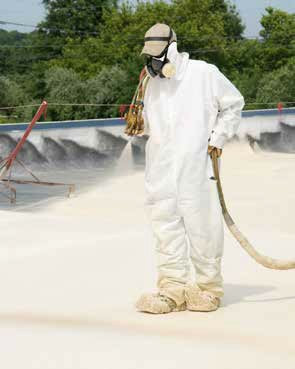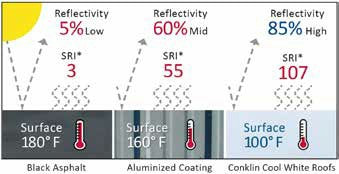Benefits of Foam Roofing for Your Commercial RoofAn increasingly large number of business owners and contractors have started to recognize the benefits of foam roofing. As a result, foam roofing is gaining popularity as one of the best options for flat roofs. The two most prominent benefits are waterproofing/leak prevention and insulation value. Many additional benefits also exist such as superior compressive strength, lightweight, self-flashing, durable and long lasting.
We are going to cover some of its most prominent benefits in comparison to other commercial roofing choices. |
What Is Spray Polyurethane Foam (SPF) Roofing?
Foam roofing is also referred to as (SPF) spray polyurethane foam roofing.
Foam roofing consists of high-density, closed-cell polymeric foam that has an elastomeric coating. Once it is applied, it binds to the roof and transforms into a solid and hard-wearing surface that allows for walking. Spray foam forms a seamless, protective barrier that insulates and waterproofs your roof, eliminating the possibility for water to penetrate through vents, pipes, and other protrusions. Thanks to its high “R” value (resistance to heat flow), which is further enhanced through the use of roof coatings, foam roofing can significantly reduce the effects of thermal shock on the structure of a building.
Spray foam is installed in liquid form by a trained technician. This allows the liquid to fill and expand to seal off any opening, crack, or crevice. This also means that spray foam roofing does not require any joints or seams. These are often the most susceptible parts of a commercial building’s roof when it comes to compromising structural quality.
It then expands approximately 30 times its original liquid volume to form a hard, closed cell monolithic roof surface. The Polyurethane Foam dries within seconds after applied to the roof surface. Its expansion results in a weather tight roofing membrane that is fully adhered to the substrate. Because of polyurethane’s lightweight it adds little additional weight to the structure and is often used in remedial applications.
Foam has a history of more than 40 years as a maintainable roofing medium. Polyurethane Foam adds excellent insulation value to the structure and utility bills can reflect the difference. Once the SPF has been applied to the proper thickness and finish specifications, a protective layer of elastomeric coating is applied. This protective layer produces a durable weather resistant surface and that can be walked on for normal maintenance.
Building owners across the United States are raving about Conklin spray foam as their choice for commercial roofing.
Foam roofing consists of high-density, closed-cell polymeric foam that has an elastomeric coating. Once it is applied, it binds to the roof and transforms into a solid and hard-wearing surface that allows for walking. Spray foam forms a seamless, protective barrier that insulates and waterproofs your roof, eliminating the possibility for water to penetrate through vents, pipes, and other protrusions. Thanks to its high “R” value (resistance to heat flow), which is further enhanced through the use of roof coatings, foam roofing can significantly reduce the effects of thermal shock on the structure of a building.
Spray foam is installed in liquid form by a trained technician. This allows the liquid to fill and expand to seal off any opening, crack, or crevice. This also means that spray foam roofing does not require any joints or seams. These are often the most susceptible parts of a commercial building’s roof when it comes to compromising structural quality.
It then expands approximately 30 times its original liquid volume to form a hard, closed cell monolithic roof surface. The Polyurethane Foam dries within seconds after applied to the roof surface. Its expansion results in a weather tight roofing membrane that is fully adhered to the substrate. Because of polyurethane’s lightweight it adds little additional weight to the structure and is often used in remedial applications.
Foam has a history of more than 40 years as a maintainable roofing medium. Polyurethane Foam adds excellent insulation value to the structure and utility bills can reflect the difference. Once the SPF has been applied to the proper thickness and finish specifications, a protective layer of elastomeric coating is applied. This protective layer produces a durable weather resistant surface and that can be walked on for normal maintenance.
Building owners across the United States are raving about Conklin spray foam as their choice for commercial roofing.
Foam roofing is an affordable and cost-effective roofing option. It contains tiny aluminum particles that reflect the sun’s UV rays and give the foam top-grade insulating properties. It a great choice for reducing energy-consumption, making a building more energy-efficient, and reducing the overall workload on the HVAC system.
Spray polyurethane foam roofing systems are excellent at insulating your building and sealing off airflow from escaping or entering the building. These systems are sprayed directly onto your rooftop (either as new construction or roof restoration) filling all cracks and openings on your roof to seal and prevent any heat loss to the building.
This is particularly important for building owners, facility managers, and contractors who need to meet strict state and municipality codes surrounding sustainability, and at the same time accommodate the increasing energy demand.
Spray polyurethane foam roofing systems are excellent at insulating your building and sealing off airflow from escaping or entering the building. These systems are sprayed directly onto your rooftop (either as new construction or roof restoration) filling all cracks and openings on your roof to seal and prevent any heat loss to the building.
This is particularly important for building owners, facility managers, and contractors who need to meet strict state and municipality codes surrounding sustainability, and at the same time accommodate the increasing energy demand.
Significant energy savings spray foam roofs have !
There are several energy-saving advantages to using spray foam for your commercial roof:
- High R-Value rating – SPF is the highest-rated commercial roofing solution when it comes to energy efficiency. The aged R-Value of an SPF roof is usually between 6.2-6.5, which is head-and-shoulders above its competition.
- Spray foam roofs are seamless, which means that they’re not allowing any energy loss or penetration of the building’s energy envelope during change in seasons or temperatures
- Spray foam roofs help minimize thermal shock because it’s seamless, has a high R-Value rating, and is protected by a white elastomeric UV coating.
Versatile Application
Foam roofing is most often applied to flat roofs, but it can also be used with sloped and dome roofs. It works equally well with metal, wood and concrete roofing, regardless of whether they’re new or old. This eliminates the need for tearing off the old roof and thus reduces overall roofing costs. It is also fast and easy to recoat or repair, and can be applied to most existing surfaces.
Waterproofing
Closed-cell polyurethane foam is by far the best water insulator on the market. It is actually the only insulating material that doesn’t soak up water, but rather repels it. Once it seals the whole roof, there is virtually no place for the water to get in and leaks become a thing of the past. It is a great choice to easily correct damaged substrate and/or poor drainage.
Preserving structural integrity
Polyurethane foam can endure the strain of normal expansion and contraction of a building’s structure. It remains sealed and adhered under all conditions, protecting the building from outside elements including winds, sunshine, rain, and hail. It can withstand hurricane force winds. It also reduces sound transmission thru the roof. It adds structural strength without adding much weight.
Site powered by Weebly. Managed by JustHost




